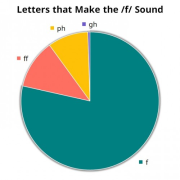How to Pronounce the /f/ Sound

In this lesson, we are going to learn more about how to pronounce the /f/ sound using the appropriate articulatory organs.
What Type of Sound Is /f/?
/f/ is a consonant in the English language.
How to Produce /f/?


As you can see, in picture (a), to produce this sound, we use both our upper teeth and our lower lip. As you can see more clearly in picture (b), we move the inside of the lower lip under the upper teeth. Note that we do not bite our lips. It is just a simple grip. If you bite your lip, the air comes out from the corners of your mouth which is wrong. The air must come out slowly from between the upper front teeth and the lower lip. As you can see, in picture (b), the uvula has blocked the air from going through the nose. The /f/ sound is voiceless. Therefore, there is no vocal chord vibration. As it is visible, the circle signifying the vocal cords in the throat remains grey.
In picture (c), we can see that the tongue does not make contact with any parts of the mouth. It is appropriate to say that the tongue does not participate in the production of this sound.
Which Letters are Pronounced as /f/?
The sound /f/ is represented by the following letters:


f:
follow /ˈfɑloʊ/
furious /ˈfjʊɹ.i.əs/
fabulous /ˈfæbjʊləs/
fasten /fæs·ən/
ff:
staff /stæf/
affix /ˈæf.ɪks/
offer /ˈɔfɚ/
sniff /snɪf/
ph:
phonology /fəˈnɑlədʒi/
alphabet /ˈæl.fə.bɪt/
sphere /sfɪr/
nephew /nɛfju/
gh:
tough /tʌf/
cough /kɑːf/
enough /əˈnʌf/
/f/ Sound in the Most Common World Languages
As you can see, in the table below, most of the common languages in the world have the /f/ sound. With the instructions provided and a little bit of practice, you can easily learn to produce this sound. Look:
Existence | Example | |
|---|---|---|
Mandarin | ✔ | 飞 (fēi) |
Spanish | ✔ | fantasma |
Hindi | ✔ | साफ़ |
Bengali | ✔ | ফুল |
Portuguese | ✔ | fala |
Russian | ✔ | орфография |
Japanese¹ | ✔ | ふじ |
Vietnamese | ✔ | pháo |
Turkish | ✔ | saf |
French | ✔ | fabuleuse |
German | ✔ | fade |
Italian | ✔ | fantasma |
Persian | ✔ | فکر |
Standard Arabic | ✔ | ظرف |
Korean | x | - |
Indonesian | ✔ | fajar |
Filipino² | ✔ | ref |
Hungarian | ✔ | figyel |
Dutch | ✔ | fiets |
Polish | ✔ | futro |
Romanian | ✔ | foc |
Swedish | ✔ | fisk |
Czech | ✔ | foukat |
Greek | ✔ | φύση |
Ukrainian | ✔ | Фастів |
Urdu | ✔ | صاف |
¹ The sound is close to the English /f/, but it is not identical.
² This sound is regional or non-native.
Listening
Below, there is an audio file that helps you learn the proper pronunciation of the /f/ sound:
Comments
(0)